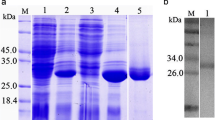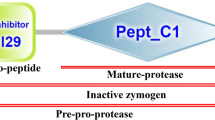Abstract
Cystatins are thiol proteinase inhibitors ubiquitously present in mammalian body and serve various important physiological functions. In the present study, a novel cystatin molecule (AcCystatin) was cloned from a cDNA library of Angiostrongylus cantonensis fourth-stage larvae. The putative 14-kDa protein contained 120 residues with cystatin-conserved motifs known to interact with the active site of cysteine peptidases and showed high identities with cystatins from other nematodes. RT-PCR analysis revealed that the expression pattern of AcCystatin was equal at the time points of third-stage larvae, fourth-stage larvae, and adults of the parasite life cycle. The recombinant AcCystatin (rAcCystatin) expressed and purified from Escherichia coli has been demonstrated to possess an obvious inhibitory activity against cathepsin B and could significantly upregulate nitric oxide production from IFN-γ activated RAW 264.7 macrophages. Sera from mice (non-permissive host) infected with A. cantonensis detected rAcCystatin by Western blot, while the sera from infected rats (permissive host) could not. The results implied that AcCystatin might be an immunoregulator in A. cantonensis infection.







Similar content being viewed by others
References
Abrahamson M, Alvarez-Fernandez M, Nathanson CM (2003) Cystatins. Biochem Soc Symp 70:179–199
Acuña-Castillo C, Aravena M, Leiva-Salcedo E, Pérez V, Gómez C, Sabaj V, Nishimura S, Pérez C, Colombo A, Walter R, Sierra F (2005) T-kininogen, a cystatin-like molecule, inhibits ERK-dependent lymphocyte proliferation. Mech Ageing Dev 126(12):1284–1291
Agarwala KL, Kawabata S, Hirata M, Miyagi M, Tsunasawa S, Iwanaga S (1996) A cysteine protease inhibitor stored in the large granules of horseshoe crab hemocytes: purification, characterization, cDNA cloning and tissue localization. J Biochem 119(1):85–94
Ahmed JS, Glass EJ, Salih DA, Seitzer U (2008) Innate immunity to tropical theileriosis. Innate Immun 14(1):5–12
Alizadeh H, Neelam S, Niederkorn JY (2007) Role of activated macrophages in Acanthamoeba keratitis. J Parasitol 93(5):1114–1120
Bisseru B (1971) The prevalence of Angiostrongylus cantonensis larvae collected from the giant African snail, Achatina fulica in west Malaysia and Singapore. Southeast Asian J Trop Med Public Health 2(4):523–526
Chen KM, Lee HH, Lai SC, Hsu LS, Wang CJ, Liu JY (2008a) Apoptosis in meningoencephalitis of Angiostrongylus cantonensis-infected mice. Exp Parasitol 119(3):385–390
Chen KM, Lee HH, Lai SC, Hsu LS, Wang CJ, Liu JY (2008) Apoptosis in meningoencephalitis of Angiostrongylus cantonensis-infected mice. Exp Parasitol119 (3):385–390
Chye SM, Lin SR, Chen YL, Chung LY, Yen CM (2004) Immuno-PCR for detection of antigen to Angiostrongylus cantonensis circulating fifth-stage worms. Clin Chem 50(1):51–57
Frendéus KH, Wallin H, Janciauskiene S, Abrahamson M (2009) Macrophage responses to interferon-gamma are dependent on cystatin C levels. Int J Biochem Cell Biol 41(11):2262–2269
Geiger SM, Abrahams-Sandi E, Soboslay PT, Hoffmann WH, Pfaff AW, Graeff-Teixeira C, Schulz-Key H (2001) Cellular immune responses and cytokine production in BALB/c and C57BL/6 mice during the acute phase of Angiostrongylus costaricensis infection. Acta Trop 80(1):59–68
Hartmann S, Lucius R (2003) Modulation of host immune responses by nematode cystatins. Int J Parasitol 33(11):1291–1302
He H, Cheng M, Yang X, Meng J, He A, Zheng X, Li Z, Guo P, Pan Z, Zhan X (2009) Preliminary molecular characterization of the human pathogen Angiostrongylus cantonensis. BMC Mol Biol 10:97
Honey K, Rudensky AY (2003) Lysosomal cysteine proteases regulate antigen presentation. Nat Rev Immunol 3(6):472–482
Hwang KP, Chen ER (1988) Study on intracranial migration of Angiostrongylus cantonensis in mice. Gaoxiong Yi Xue Ke Xue Za Zhi 4(1):10–14.
Hwang KP, Chen ER (1991) Clinical studies on Angiostrongyliasis cantonensis among children in Taiwan. Southeast Asian J Trop Med Public Health 22(Suppl):194–199
Joshua GWP, Perler FB, Wang CC (1995) Orphon spliced leader sequences form part of a repetitive element in Angiostrongylus cantonensis. Nucleic Acids Res 23(6):1030–1035
Kanazawa T, Asahi H, Hata H, Mochida K, Kagei N, Stadecker MJ (1993) Arginine-dependent generation of reactive nitrogen intermediates is instrumental in the in vitro killing of protoscoleces of Echinococcus multilocularis by activated macrophages. Parasite Immunol 15(11):619–623
Kolodziej H, Radtke OA, Kiderlen AF (2008) Stimulus (polyphenol, IFN-gamma, LPS)-dependent nitric oxide production and antileishmanial effects in RAW 264.7 macrophages. Phytochemistry 69(18):3103–3110
Kopitar-Jerala N (2006) The role of cystatins in cells of the immune system. FEBS Lett 580(27):6295–6301
Kos J, Lah TT (1998) Cysteine proteinases and their endogenous inhibitors: target proteins for prognosis, diagnosis and therapy in cancer (review). Oncol Rep 5(6):1349–1361
Lan KP, Lai SC (2009) Differences of proteolytic enzymes and pathological changes in permissive and nonpermissive animal hosts for Angiostrongylus cantonensis infection. Vet Parasitol 165(3–4):265–272
Leiro J, Iglesias R, Paramá A, Sanmartín ML, Ubeira FM (2001) Effect of Tetramicra brevifilum (microspora) infection on respiratory-burst responses of turbot (Scophthalmus maximus L.) phagocytes. Fish Shellfish Immunol 11(7):639–652
Lv S, Zhang Y, Liu HX, Hu L, Yang K, Steinmann P, Chen Z, Wang LY, Utzinger J, Zhou XN (2009) Invasive snails and an emerging infectious disease: results from the first national survey on Angiostrongylus cantonensis in China. PLoS Negl Trop Dis 3(2):e368
Manoury B, Gregory WF, Maizels RM, Watts C (2001) Bm-CPI-2, a cystatin homolog secreted by the filarial parasite Brugia malayi, inhibits class II MHC-restricted antigen processing. Curr Biol 11(6):447–451
Marletta MA (1993) Nitric oxide synthase structure and mechanism. J Biol Chem 268(17):12231–12234
Nye SW, Tangchai P, Sundarakiti S, Punyagupta S (1970) Lesions of the brain in eosinophilic meningitis. Arch pathol 89(1):9–19
Schierack P, Lucius R, Sonnenburg B, Schilling K, Hartmann S (2003) Parasite-specific immunomodulatory functions of filarial cystatin. Infect Immun 71(5):2422–2429
Sukhova GK, Zhang Y, Pan JH, Wada Y, Yamamoto T, Naito M, Kodama T, Tsimikas S, Witztum JL, Lu ML, Sakara Y, Chin MT, Libby P, Shi GP (2003) Deficiency of cathepsin S reduces atherosclerosis in LDL receptor-deficient mice. J clin invest 111(6):897–906
Tarasuk M, Vichasri Grams S, Viyanant V, Grams R (2009) Type I cystatin (stefin) is a major component of Fasciola gigantica excretion/secretion product. Mol Biochem Parasitol 167(1):60–71
Tu WC, Lai SC (2006) Induction of tumour necrosis factor, interleukin-1beta and matrix metalloproteinases in pulmonary fibrosis of rats infected with Angiostrongylus cantonensis. J Helminthol 80(3):305–311
van Eijk M, van Noorden CJ, de Groot C (2003) Proteinases and their inhibitors in the immune system. Int Rev Cytol 222:197–236
Verdot L, Lalmanach G, Vercruysse V, Hartmann S, Lucius R, Hoebeke J, Gauthier F, Vray B (1996) Cystatins up-regulate nitric oxide release from interferon-gamma-activated mouse peritoneal macrophages. J Biol Chem 271(45):28077–28081
Vray B, Hartmann S, Hoebeke J (2002) Immunomodulatory properties of cystatins. Cell Mol Life Sci 59(9):1503–1512
Zafra R, Jaber JR, Pérez-Ecija RA, Barragán A, Martínez-Moreno A, Pérez J (2008) High iNOS expression in macrophages in canine leishmaniasis is associated with low intracellular parasite burden. Vet Immunol Immunopathol 123(3–4):353–359
Zavasnik-Bergant T (2008) Cystatin protease inhibitors and immune functions. Front Biosci 13:4625–4637
Zhou J, Ueda M, Umemiya R, Battsetseg B, Boldbaatar D, Xuan X, Fujisaki K (2006) A secreted cystatin from the tick Haemaphysalis longicornis and its distinct expression patterns in relation to innate immunity. Insect Biochem Mol Biol 36(7):527–535
Zhou YP, Wu ZD, Yang LL, Sun X, You X, Yu XB, Hu W, Zheng HQ, Lv ZY (2009) Cloning, molecular characterization of a 13-kDa antigen from Schistosoma japonicum, Sj13, a putative salivary diagnosis candidate for Schistosomiasis japonica. Parasitol Res 105(5):1435–1444
Acknowledgments
We are grateful to Pro. Qing-yu He, Mrs. Jie Liu, Dr. Jue-heng Wu, and Dr. Xun Zhu for their expert technical assistances in mass spectrometry, confocal microscopy, and fluorescence microplate reader, respectively. This work was supported by a grant from the National Basic Research Program of China (2010CB530004), the National Natural Science Foundation of China (30771888, 30800966), and Research Fund for Students of Sun Yat-sen University (2010).
Author information
Authors and Affiliations
Corresponding authors
Additional information
Yu-hong Liu and Yan-ping Han made equal contribution to this work.
Rights and permissions
About this article
Cite this article
Liu, Yh., Han, Yp., Li, Zy. et al. Molecular cloning and characterization of cystatin, a cysteine protease inhibitor, from Angiostrongylus cantonensis . Parasitol Res 107, 915–922 (2010). https://doi.org/10.1007/s00436-010-1952-5
Received:
Accepted:
Published:
Issue Date:
DOI: https://doi.org/10.1007/s00436-010-1952-5




